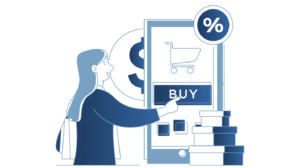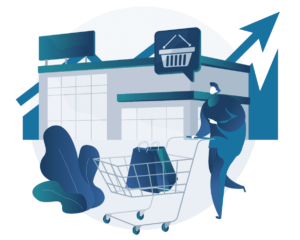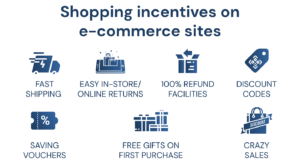Predictive Marketing Analytics in Retail
Using predictive analytics in the retail industry Brick and Clicks stores commence designing, developing, and deploying a data-driven and analytic customer acquisition, engagement, and retention platform. Predictive analytics is an umbrella technology that covers a range of statistical/analytical tools to recognize data patterns or trends and predict future behaviors. To begin with …
The concept of predictive analytics in retail is not particularly new. It’ll continue evolving likewise or new applications within and beyond Brick and Clicks. Not only it’s easily available to an average merchant, but also real-time customer forecasts are making it more practical for predictive marketing than ever before. Did you Know? Predictive marketing is an approach of predictive analytics, not technology itself. In fact, predictive analytics works as a fuel to predictive marketing in three different ways: Touch most relevant customers ONLY Using big data and artificial intelligence (AI) applications to classify customer groups into clusters Using data science to predict future customers
However, if you don’t have a large team of data scientists on board, it may be hard for you to create predictive analytics solutions on your own. Thus, several data science service providers can help you generate accurate Sales and Marketing (S&M) predictions based on historical/real-time customer data from various sources (e.g., POS systems). In this article, we will discuss how predictive analytics can optimize the S&M strategies of Brick and Clicks stores. Also, how it can improve customer retention, increase revenue, and reduce costs.
What Is A Brick-And-Click Model?
A “click” can be defined as a customer ordering or purchasing a product or service via a website (online store). A “brick” is short for “bricks and mortar.” It’s an offline store where you can view, touch, smell, and handle products before you buy them.
Why Do Companies Prefer Both Brick and Clicks Models?
The main advantage of the Brick and Clicks approach is its flexibility. Businesses can use the Brick and Clicks model to complement their existing marketing strategies. For example, a company might decide to use online sales as a way to promote brick-and-mortar sales. The more people know the brand, the more likely they are to visit the brick-and-mortar location in person. The company can then use its brick-and-mortar location as an advertisement for its online store by offering the best incentives for e-commerce sites, such as:
- Fast Shipping
- Easy in-store/online Returns
- 100% Refund Facilities
- Discount Codes
- Saving Vouchers
- Crazy Sales
- Free Gifts on First Purchase
Omnichannel Retail – Next Big Thing in Retail Industry
Blending online shoppers with in-store sales is the next big thing in the retail industry. The click-and-brick retailers use omnichannel retail (both online and offline sales) to reach and convert more customers. Reading between the lines, it appears that businesses that stick with an omnichannel strategy will have the edge over those that don’t. A recent 2020 Omnichannel Report from Radial says that 78% of online consumers have used the omnichannel feature in the first 6 months of 2020.
The Role of Big Data and Predictive Analytics in Retailing

Even more, predictive analytics in retail go much deeper than just looking at past behavior. Retailers collect humongous amounts of data from various sources such as websites, data warehouses, call centers, sales transactions, and consumer feedback. But without predictive analytics, they will be stuck. Because it helps retailers determine a range of likewise WWW factors, such as: What is their customer’s location? What do they need the most? And so…Which products will be popular?
Furthermore, Big data refers to a large volume of information that can be analyzed quickly to gain insights. It is generated by different sources like social media, mobile devices, sensors, ERP systems, etc.So, the power of predictive analytics lies in its ability to infer information from available data, which will allow businesses to make more accurate predictions and relevant business decisions. Such as how much inventory to order and when or how to price products. Particularly, predictive analytics feature retail stores with:
- Robust POS system
- Consistent Inventory Management
- Level up retail merchandising
- Easy returns and shipping
- Mobile Optimization
Examples of Predictive Analytics in Retail Stores
Predictive analytics can be used in a variety of ways. It can help companies decide how many sales are needed based on a customer’s likely response to a particular sales pitch.
Retail Supply Chain Predictive Analytics
Taco Bell uses supply chain predictive analytics to predict orders and real-time ingredient shortages. Also, Taco Bell employs “predictive market mapping” to know the “total revenue” and “sales (%)” it might snatch from competitor restaurants. And because of it, Taco Bell can avoid “Corporate Cannibalism.”
Predictive Churn Analytics
Bloomingdale has integrated Power BI dashboards to display real-time key customer segments. Further, they’ve got an advanced cloud platform to build financial forecasts, predictive churn analytics, and per-segment lifetime value of their consumers. To put it another way, profitable retailers also predict what customers are likely to do in-store based on what they have done online. But the question is: how customers can make an in-store purchase after adding things to their online cart? To clarify this, a perfect use-case of in-store predictive analytics can be an omnichannel retail experience.

What’s Next in Omnichannel Retail Experience Use Cases
To begin with, it’s not about your store’s location in today’s omnichannel shopping world but more about your consumer’s location. Samsung is the best example of retailers that blend customer journey with AI-integrated retail analytics. Empowering with retail analytics, Samsung converts window shoppers to buyers through digital signage. At this step, heat sensors and mapping can sense their customer’s physical steps and see where they stay longer.
Even more, smart display units can then optimize upsells through relevant product recommendations based on time, customer location, or other custom data. For example, if a customer has purchased 3 LED bulbs, then predictive analytics might offer them a light fixture so they can continue shopping for lighting products.
Personalizing Your Customer’s Omnichannel Experience
Many retailers, especially in the developing world, may assume they know everything about their shopper’s behavior without any data. However, that’s not possible without real-time data collection. Heat mapping can help for sure in this regard, as you can make well-informed predictions and determine critical conversion funnel opportunities.

The fast sensor is an AI-powered tech addition in the retail industry that gathers real-time customer physical traffic insights from inside marts and stores data on a cloud server. Then, this data is analyzed to get actionable suggestions for the re-optimization of product displays in-store. How do Fastsensors work? What do they display? Heat sensors are integrated into this technology to “detect” a customer in a certain product’s vicinity. Then, to display most relevant on-shelf suggestions, such as:
- Discount Coupons
- Product photos/reviews
- Likewise Items recommendations
- Warranty offer
- 0.5-1 min product display video
Distribute Relevant Content
Customers shopping on your site expect instant gratification. Samsung’s content management system – MagicINFO, is found to be a gamechanger in the content generation world. It can quickly create, manage, and publish real-time content using just a single innovative platform. It helps you with automatic troubleshooting of every single technical issue in your content.
Moreover, MagicINFO’s integration into your predictive analytics solution can ensure live announcements, showcase upcoming inventory, or alert in-store customers about the next weather events. It also helps you with the automatic scheduling of upcoming promotions and further automates marketing tasks. Even more, you don’t have to worry about printing promotion materials, as MagicINFO can really reduce your brand’s carbon footprint, reducing costs in return. Your overhead also drops with MagicINFO as only one employee can handle all marketing tasks at once. You can have marketing response reports along with detailed in-store and online predictive marketing analytics using this single predictive marketing tool.
3D Mapping to Maximize Throughput
Once you have viewed your brand’s performance reports and you know that your store isn’t optimized enough to convert window shoppers into loyal customers, you can use that data to organize and re-optimize your store. A trendy technique in the retail industry is 3D mapping for this purpose. It gives store re-design guesses and ensures customer conversion optimization thru before-and-after detailed marketing analytics data.

For instance, grocery stores often place chocolates or candies near dairy products in the store’s back. But if you know which sections customers are more convenient reaching with, you’ll be able to re-organize chocolate aisles near the billing counters. Since brick-and-mortar stores are now taking challenges to integrate AI-based analytics. So, other retailers also need to rush into innovative digital solutions. As it’ll embrace them to meet their brand’s community needs.










